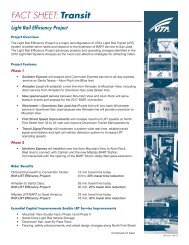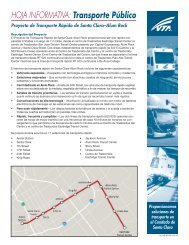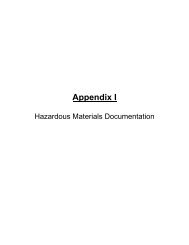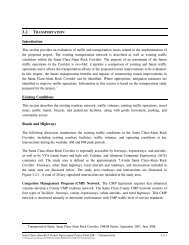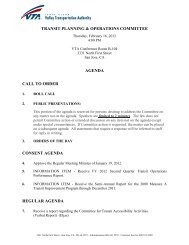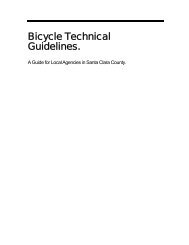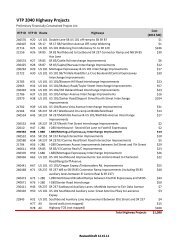Vegetation Maintenance Inspection and Recommendations - VTA
Vegetation Maintenance Inspection and Recommendations - VTA
Vegetation Maintenance Inspection and Recommendations - VTA
Create successful ePaper yourself
Turn your PDF publications into a flip-book with our unique Google optimized e-Paper software.
16 January 2012<br />
MEMORANDUM<br />
TO: Ann Calnan (Valley Transportation Authority)<br />
FROM: Joe Howard <strong>and</strong> Carrie Jensen<br />
PROJECT #2995-04<br />
CC: Lani Lee Ho (Valley Transportation Authority); Max Busnardo, Dan Stephens,<br />
Matt Quinn (H. T. Harvey & Associates)<br />
SUBJECT: Wrigley Creek Improvement Project, <strong>Vegetation</strong> <strong>Maintenance</strong> <strong>Inspection</strong><br />
<strong>and</strong> <strong>Recommendations</strong><br />
H. T. Harvey & Associates’(HTH) Carrie Jensen visited the Wrigley Creek Improvement Project<br />
on 10 January 2012, to perform a vegetation maintenance inspection <strong>and</strong> assess weed control <strong>and</strong><br />
soil moisture. This memor<strong>and</strong>um summarizes her observations <strong>and</strong> HTH’s maintenance<br />
recommendations.<br />
Overall the site was well maintained, weed cover was low, <strong>and</strong> the soil moisture was sufficient<br />
but quickly diminishing. The basins were well maintained with sufficient mulch levels <strong>and</strong><br />
wooden stakes. The majority of container plants had high health <strong>and</strong> vigor <strong>and</strong> some had new<br />
growth. Weed cover averaged less than 6" high, <strong>and</strong> weeds are being actively controlled across<br />
the site. The dense patches of nonnative, invasive herbaceous species observed during the last<br />
maintenance inspection had died back, presumably from herbicide treatments; these species<br />
included cheeseweed (Malva sp.), wild radish (Raphanus raphanistrum), bristly ox tongue<br />
(Picris echioides), <strong>and</strong> wild beet (Beta vulgaris) (Figure 1). The st<strong>and</strong>s of nonnative, invasive<br />
barnyard grass (Echinochloa crus-galli) in the channel had been mowed/weed whipped. There<br />
were numerous native wetl<strong>and</strong> plant species in the floodplain such as iris-leaved rushes (Juncus<br />
xiphiodes) <strong>and</strong> flatsedges (Cyperus eragrostis) <strong>and</strong> several native species in the upl<strong>and</strong>s<br />
including mugwort (Artemisia douglasiana) <strong>and</strong> yarrow (Achillea millefolium). Care had been<br />
taken to avoid these native species during weeding events.<br />
A few noxious/invasive species were observed on the site. There were still a few scattered<br />
stinkwort (Dittrichia graveolens) individuals with seed on the west bank (Figure 2). English ivy<br />
(Hedera helix) was overhanging into the project site on some sections of the eastern fence line<br />
(Figure 3). There was one Canary Isl<strong>and</strong> date palm (Phoenix canariensis) also along this eastern<br />
fence line (Figure 4). Soil moisture was variable <strong>and</strong> followed a gradient from saturated soils<br />
along the channel to drier soils in the upl<strong>and</strong> planting zones. All areas had at least some moisture<br />
at depths of 4 inches or greater; however, in the absence of rain, this moisture will quickly<br />
diminish.<br />
983 University Avenue, Building D Los Gatos, CA 95032 Ph: 408.458.3200 F: 408.458.3210
2<br />
Dense weed<br />
patches have<br />
died back.<br />
Figure 1: On the southwest top of bank dense patches of weeds have died<br />
back.<br />
Stinkwort<br />
Figure 2: Stinkwort gone to seed on the west bank near the additional<br />
outfall structure.<br />
H. T. HARVEY & ASSOCIATES
Figure 3: English ivy hanging over the eastern fence into the project site.<br />
Figure 4: Canary Isl<strong>and</strong> date palm <strong>and</strong> English ivy along the eastern fence<br />
line.<br />
3<br />
H. T. HARVEY & ASSOCIATES
Discussion <strong>and</strong> <strong>Recommendations</strong><br />
The following are our recommendations for compliance with specification Section 32 95 00<br />
Plant Establishment Period <strong>and</strong> Long-term L<strong>and</strong>scaping <strong>Maintenance</strong>.<br />
1. All noxious/invasive plants shall be removed from the planting area limits, including<br />
stinkwort, Canary Isl<strong>and</strong> date palm, <strong>and</strong> English ivy. The few remaining stinkwort<br />
individuals with seed should be bagged <strong>and</strong> removed from the site. The one Canary<br />
Isl<strong>and</strong> date palm individual should be removed. The English ivy that is encroaching into<br />
the site over the eastern fence should be pruned off of the project’s side of the fence<br />
before the berries mature in the spring; care should be taken to avoid damaging the fence.<br />
All material of these species should be removed from the site <strong>and</strong> properly disposed off<br />
of the site because even small pieces of remaining material may re-root if left in contact<br />
with the soil.<br />
2. Due to the lack of rain <strong>and</strong> decreasing soil moisture on the site, the <strong>VTA</strong> may want to<br />
consider adjusting the irrigation schedule per the specifications to provide sufficient<br />
water to maintain plant health. We will continue to monitor the forecast on a weekly basis<br />
<strong>and</strong> follow-up with recommendations on the appropriate timing of winter irrigation<br />
events, if necessary.<br />
Please feel free to contact Joe Howard at jhoward@haveyecology.com or 408.458.3224 or<br />
Carrie Jensen at cjensen@haveyecology.com or 408.458.3234 if you have any questions.<br />
4<br />
H. T. HARVEY & ASSOCIATES



